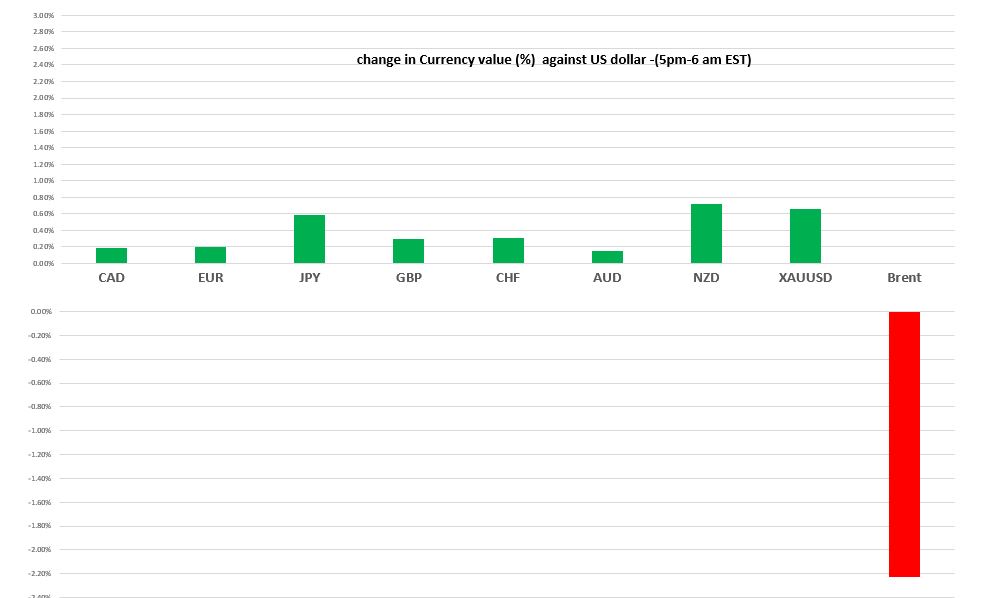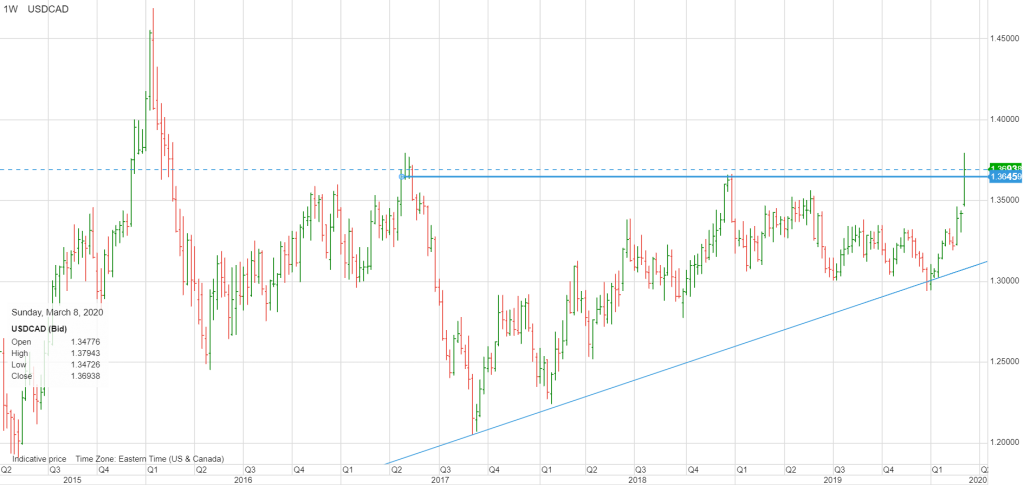
March 11, 2020
USDCAD open (6:00 am EST) 1.3687-91 Overnight Range 1.3684-1.3745
- Bank of England cuts bank rate by 50 basis points to 0.25% and announced new Term Funding scheme, to bolster cash flows of businesses, and households.
- Saudi Arabia and Russia oil price war escalates. Saudi Aramco ordered to raise planned April crude production to 13.0 mb/d from 12.2 mb/d, on Monday.
- ECB’s Lagarde urges EU officials to act or face 2008-style crisis
- Lack of progress on US stimulus package to combat coronavirus, sends US equity futures lower and gold prices higher.
- US dollar gives back some of yesterday’s gains, opening with losses across the major G-10 spectrum
Chart: Currency gain/loss (%) against the US dollar from NY close to NY open (6:00 EST)

Source: Saxo Bank/IFXA
FX Recap and outlook: The Bank of England surprised markets by cutting its Bank rate to 0.25%, a level last seen in August 2016. The move is expected to be followed up by a series of stimulus measures to be announced by the Treasury, later today. GBPUSD dropped, then soared in a 1.2834-1.2975 range, and opening in New York at 1.2956. UK data, including Jan GDP (actual ).0% vs forecast 0.2%) was not a factor.
EURUSD climbed steadily in Asia, in response to the failure of the US administration to enact any stimulus measures. Prices rose to 1.1366 from 1.1282, before retreating during the European session. ECB President Christine Lagarde’s warning that a lack of stimulus action from EU governments risks a 2008-style financial crisis weighed on the currency and prices dropped to 1.1310 in early New York trading.
USDJPY price action mirrored that of EURUSD and US Treasury yield movements. 10-year Treasury yields bounced in a 0.578-0.788% range and opened in NY at 0.705%.
Traders were also disappointment from the lack of a US stimulus package, but hopeful about a reported Japanese government plan for a new economic package in April. USDJPY bounced in a 104.10 -105.62 range and opened in New York at 105.02.
NZDUSD out-performed AUDUSD after New Zealand Electronic Card Retail Sales data surprised to the upside (Actual 8.6% m/m vs forecast 4.1% m/m).
AUDUSD was underpinned by the government’s news of an AUD$ 2.4 billion coronavirus health package.
WTI oil prices are choppy in a $33.32-36.32/barrel trading range. Concerns that the Saudi’s will ramp up production were off-set, to a degree by reports US officials were considering replenishing the Strategic oil reserves.
USDCAD spiked to 1.3790 yesterday on the back of broad US dollar demand, and the drop in oil prices. Traders were unnerved by the Canadian government’s apparent disarray in crafting an economic response to the COVID-19 outbreak, which may have spurred Trudeau into action. He is expected to announce an economic package today. USDCAD was also supported by speculation the BoC would follow the Fed’s lead and announce another rate cut.
There aren’t any top tier US or Canadian economic data available today. Once again, coronavirus news, Wall Street price action, and US economic stimulus plans will drive trading.
USDCAD Technical Outlook
USDCAD continues to consolidate losses following the break above 1.3450. However, yesterday’s push to 1.3790 and then drop below 1.3710 overnight shifted the intraday sentiment to negative with the Friday-Monday opening gap between 1.3434 and 1.3480 acting as a beacon. Nevertheless, the medium-term outlook is bullish above 1.3360, supported by the break above 1.3560. For today, USDCAD support is at 1.3640 and 1.3610. Resistance is at 1.3710 and 1.3760. Today’s range 1.3660-1.3740.
Chart: USDCAD 1 week

Source: Saxo Bank





